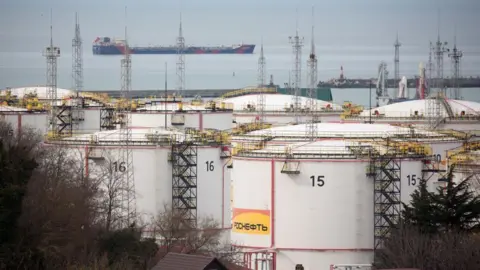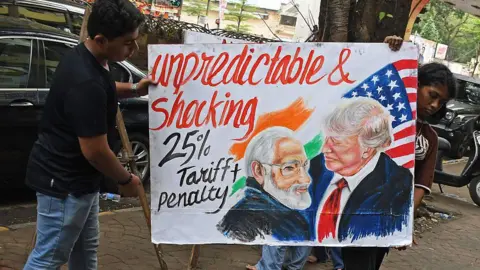 Getty images
Getty imagesDespite being the world’s most approved country, Russia has continued to use its vast energy money to ban his war in Ukraine.
US President Donald Trump is expecting to change it. He has Announced that the new secondary tariff is comprehensive If the ceasefire with Ukraine does not agree till Friday 8 August, any country will have an impact on trading with Russia.
Secondary tariff will see goods from any country that trades with Russia’s face A 100% tax When they are imported into the US.
Oil and gas are Russia’s largest exports, and Moscow’s largest customers include China, India and Turkey.
Trump last month said Trump, “I used business for many things, but it’s great to deal with wars.”
This will not be the first time the Trump administration has imposed secondary tariffs, which are also for punishing Venezuela oil buyers.
However, using them against Russia will be very large implications for the global economy.
Russia remains the world’s third largest oil producer only behind Saudi Arabia and America. But its shipments are falling this year, according to A Bloomberg analysis Ship-tracking data.
 Bloomberg
BloombergEnergy growth has increased
“The major channels by which the secondary tariffs on buyers of Russian energy can affect the global economy, through the level of energy prices,” Kiran Tompakins of Consultancy Capital Economics.
If tariffs work, they will cut the flow of dandruff and gas in the global markets.
And with low supply, prices can go up, such as they did when Russia began its full -scale invasion of Ukraine in 2022. This increased inflation worldwide. President Trump says he is not worried due to the US oil production record.
Mr. Tompkins states that, this time, there are other reasons to suggest that prices will not be marked as an impact.
He explains that “the current background is one where OPEC+ (Group of major oil producing countries and its colleagues) has significant additional ability to draw.”
Russia has designed a complete system to avoid existing restrictions, which may be useful to help its business partners to avoid the secondary tariffs with danger by Trump.
For example, its so -called “shadow fleet” – which include hundreds of tankers with unclear -owned – can be used to hide the origin of exported Russian oil and gas.
“The maintenance of sanctions is as big as the first place to implement restrictions to the first place,” says Richard Nephew, an expert on the US sanctions of Columbia University.
“This is because they take steps to take out the party that is being approved.”
 Ashish Vaishnav/SOPA images/Lighteroct via Getty Image
Ashish Vaishnav/SOPA images/Lighteroct via Getty ImagePricier iPhones from India
India has been the second largest buyer of Russian oil since the full -scale invasion of Ukraine in 2022, According to Center for Research on Energy and Clean Air,
“They are fueling the war machine. And if they are going to do so, I am not going to be happy,” President Trump told the US outlet CNBC on Tuesday.
If secondary restrictions are effective, American companies buying goods from India will have to import 100% – or pay tariffs – when those products reach our coasts.
The idea is that it makes these goods so expensive that American businesses will opt for them to buy cheaper from elsewhere, resulting in lost revenue for India.
In turn, India is considered to prevent Russian oil from buying. And if Russia is left unable to sell its oil elsewhere as other countries face the same prediction, then it will have less cash to finance war in Ukraine.
A method in which Americans could experience high prices as a result of new secondary tariffs, in the purchase of mobile phones from India.
US firm Apple is participating most of its iPhone India’s production – Especially the construction of handsets that it wants to sell in America.
If these products are subject to new tariffs, prices may double for American consumers. This is because tariffs are paid by companies that import goods – and those companies are the most close, if not, their costs increase on their customers.
Imports from India to the US are already facing 25% tariffs as part of President Trump’s wider trade shake-up, and they told CNBC that the number could be “quite quite high”.
The Government of India has accused the US of double standards, pointing to its constant trade with Russia.
Most of that trade is made up of American imports from India, which was more than $ 3BN (£ 2.2bn) last year – although it is just 10% of the 2021 levels.
The business dominates the purchase of raw materials for nuclear power and fertilizers. Russia is a major global supplier of both.
Business talks with china
China is buying the most Russian oil, and will be more challenging to complete a decision by President Trump to put a secondary tariff on Chinese goods.
This is because America’s imports from China are five times higher than the people of India, and more of those imports are consumer goods such as toys, clothes and electronics.
Secondary tariffs will also risk bothering for Beijing Extensive rebellion of trade Between the two largest economies in the world who have been in the Trump office since their first term.
“This type of over-escation is unlikely to affect sugar,” says Simon Annit, trade expert professor at IMD Business School.
He explains that it would be “very difficult” to peel the sugar from Russians without a good reason, given how the President Xi and Putin closely. Has worked together In recent years.
At her top, last time Trump tried to use the Triple -Figure Tariff against China, found that it did not work – because it almost cut all the trades between the two countries.
Another such step can add inflation pressure to the US, which Trump has pledged to deal with a long time.
It can also spend a large amount of manufacturing jobs in China, at a time when its economy is already struggling on many fronts.
More losses to US-EU commerce
Analysis by Finland -based Center for Research and Clean Air suggests that the European Union and Türkiye are still among the largest buyers of Russian energy.
Prior to 2022, the European Union was a number-one export destination for Russia, although it has reduced considerably since the full-scale invasion of Ukraine. Brussels recently agreed to buy a lot Energy more than americaBut there are some imports from Russia.
In June, the Chairman of the European Commission, Ursula von Der Leyen, Accepted the problem“Russia has repeatedly tried to blackmail us by making us our energy supply weapons” as it planned to abolish imports by the end of 2027.
The US-EU business relationship is the largest in the world, and the pair has only negotiated on new trade terms Which will apply 15% tariffs on most European Union exports to the US.
Many in the European Union Criticized that dealSaying that tariffs will harm European exporters.
They now also fears that secondary restrictions on the European Union may do even more damage. Adding 100% tariffs to buy Russian energy can reduce the amount of goods sold by the European Union in the US.
Although the largest vendors include pharmaceuticals and machinery, which can be difficult for the source from elsewhere – meaning that Americans have very few options but to pay more.
Potential dandruff recession
Russia’s own economy has so far proven to be remarkably flexible as Ukraine’s full -scale invasion began, growing 4.3% last year.
However, economy minister Maxim Reshtnikov Warned recently The country was “on the verge” of the recession after the period of “overheating”. The International Monetary Fund (IMF) is estimating just 0.9% increase this year.
If secondary restrictions are successful in reducing the demand for export, they will push Russia close to the recession.
It is difficult to know the exact impact of war on Russia’s economy, as Moscow has prevented large amounts of economic data from being published since full -scale invasion – including oil and gas production.
Nearly one -third of the Russian government is funded by oil and gas money, but exports are falling.
Meanwhile, Putin is directing a larger part of spending towards defense than at any time since the Cold War. Defense expenses are believed to have reached 6.3% of GDP.
In contrast, Ukraine is spending a large 26% of the value of its distance economy on war. The difference explains why its president, VodiMir Zelansky has repeatedly sought external help from his colleagues.
Trump’s tariff aims to help Zelansky by cutting the amount of money flowing in Russia, and hopes that death, pain and destruction in Ukraine will be eliminated.
